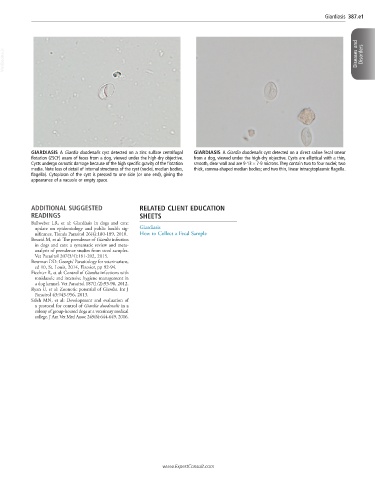Page 818 - Cote clinical veterinary advisor dogs and cats 4th
P. 818
Giardiasis 387.e1
VetBooks.ir Diseases and Disorders
GIARDIASIS A Giardia duodenalis cyst detected on a zinc sulfate centrifugal GIARDIASIS A Giardia duodenalis cyst detected on a direct saline fecal smear
flotation (ZSCF) exam of feces from a dog, viewed under the high-dry objective. from a dog, viewed under the high-dry objective. Cysts are elliptical with a thin,
Cysts undergo osmotic damage because of the high specific gravity of the flotation smooth, clear wall and are 9-13 × 7-9 microns. They contain two to four nuclei; two
media. Note loss of detail of internal structures of the cyst (nuclei, median bodies, thick, comma-shaped median bodies; and two thin, linear intracytoplasmic flagella.
flagella). Cytoplasm of the cyst is pressed to one side (or one end), giving the
appearance of a vacuole or empty space.
ADDITIONAL SUGGESTED RELATED CLIENT EDUCATION
READINGS SHEETS
Ballweber LR, et al: Giardiasis in dogs and cats:
update on epidemiology and public health sig- Giardiasis
nificance. Trends Parasitol 26(4):180-189, 2010. How to Collect a Fecal Sample
Bouzid M, et al: The prevalence of Giardia infection
in dogs and cats: a systematic review and meta-
analysis of prevalence studies from stool samples.
Vet Parasitol 207(3/4):181-202, 2015.
Bowman DD: Georgis’ Parasitology for veterinarians,
ed 10, St. Louis, 2014, Elsevier, pp 92-94.
Fiechter R, et al: Control of Giardia infections with
ronidazole and intensive hygiene management in
a dog kennel. Vet Parasitol 187(1/2):93-98, 2012.
Ryan U, et al: Zoonotic potential of Giardia. Int J
Parasitol 43:943-956, 2013.
Saleh MN, et al: Development and evaluation of
a protocol for control of Giardia duodenalis in a
colony of group-housed dogs at a veterinary medical
college. J Am Vet Med Assoc 249(6):644-649, 2016.
www.ExpertConsult.com

